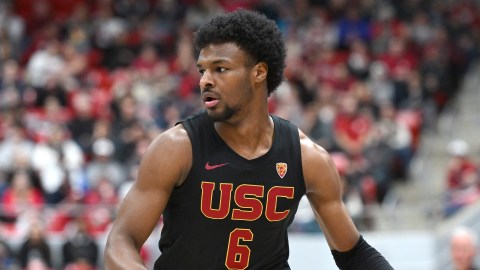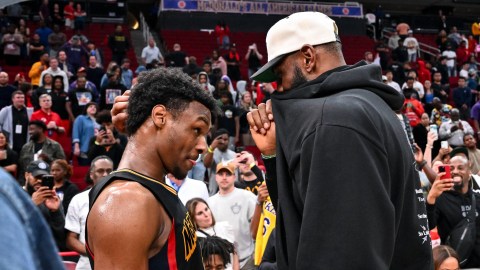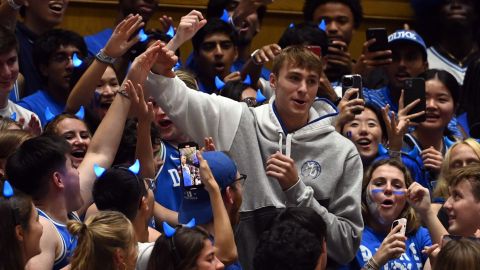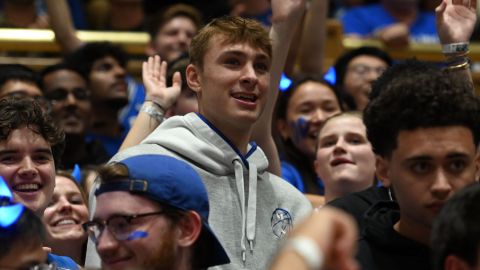 At long last, draft day is upon us. Despite pretty much every pick being traded multiple times on Twitter over the past week-plus, every team is still in its slot for the 2014 NBA draft later Thursday night.
At long last, draft day is upon us. Despite pretty much every pick being traded multiple times on Twitter over the past week-plus, every team is still in its slot for the 2014 NBA draft later Thursday night.
The Cavs are still picking first, for now, and Joel Embiid is still recuperating from foot surgery, unfortunately. An already wide-open draft has pretty much had its doors blown off completely. But in just a few hours, the rumors, reports and flat-out fabrications will be meaningless when the teams are actually on the clock.
This is our final 2014 NBA mock draft, filling out a week-long draft preview extravaganza. We began by ranking the top 15 guards on Monday, added the top 15 forwards on Tuesday and brought you the top 10 centers on Wednesday. (Even finding 10 centers worth ranking was a challenge.)
As usual, ignore which teams are making the picks here. Not only are we strict adherents to the “best available” draft philosophy, but with all the movement rumored to come on draft night, which team is picking where could well be irrelevant by the time each pick arrives.
1. Cleveland Cavaliers: Andrew Wiggins, Kansas (SF/SG, 6-foot-8, 200 pounds)
Wiggins has been our No. 1 for weeks, and Joel Embiid’s latest injury should cement Wiggins’ spot atop the draft. No other prospect matches Wiggins’ potential to become a two-way star. He’s not as NBA-ready from a scoring standpoint as Jabari Parker, but his defensive and playmaking ceiling is higher.
2. Milwaukee Bucks: Jabari Parker, Duke (F, 6-8, 240)
There are two great options at the top of this draft, meaning the Bucks will get a great player no matter who goes first. Parker looks like a future NBA scoring champ in the making and can be a tremendous rebounder and defender, when he wants to be. His effort on the defensive end and conditioning will be major points of emphasis from whichever team drafts him.
3. Philadelphia 76ers: Dante Exum, Australia (G, 6-6, 180)
For a while, Exum was being discussed as a dark-horse No. 1 pick. That’s probably too high, but with Embiid falling, Exum bumps into the top three. Scouts are split over whether he is a point guard or a shooting guard, which has caused him to fall in some people’s eyes over the last week. He has the size, ballhandling and defense are starting-caliber, but his jump shot needs to catch up.
4. Orlando Magic: Noah Vonleh, Indiana (PF, 6-10, 240)
If a team is looking for a promising big man near the top of this draft but is scared off of Embiid, Vonleh could be an acceptable alternative. He’s young (he turns 19 later this summer), which means there is still room for him to develop. Even now, he is a strong rebounder who can score both inside and out.
5. Utah Jazz: Aaron Gordon, Arizona (F, 6-8, 210)
Gordon’s defense is elite, and everyone who has seen him throughout the pre-draft process says his offensive game has taken strides as well. Though he doesn’t have much in the way of shooting, dribbling or offensive moves, he is a phenomenal athlete known for a tireless work ethic.
6. Boston Celtics: Marcus Smart, Oklahoma State (PG, 6-2, 225)
Again, pay very little attention to the teams in this mock draft; picks are so fluid in the NBA draft, the team doing the drafting is often irrelevant. So don’t take this pick as the death knell for Rajon Rondo in Boston. Smart’s ballhandling, defense and competitiveness would make the best player on the board here, whoever owns the pick.
7. Los Angeles Lakers: Julius Randle, Kentucky (PF, 6-9, 225)
Randle’s pre-draft odyssey has been odd. He bolstered his draft stock during Kentucky’s run to the NCAA championship game, but he did not seem to embrace the challenges of the combine or workout process. On the court, he is tenacious in the post and on the glass, but he is not a good defender and his length is questionable for an NBA big.
8. Sacramento Kings: Joel Embiid, Kansas (C, 7-0, 250)
How the mighty have fallen. Embiid still scares the daylights out of us, but at this point his potential (if healthy) far outweighs the middling payoff of every player to come after. He could be the fulcrum of an offense out of the post and a rim-protector on defense, both at All-Star levels — again, if he stays healthy.
9. Charlotte Hornets (from Pistons): Doug McDermott, Creighton (SF, 6-8, 210)
Stop it with the Larry Bird comparisons. McDermott finished his college career with the fifth-most points in NCAA history, which means he can pour in buckets with the best of them, but he will need to improve his passing and defense drastically to be an impact player in the NBA. Still, he is tailor made to be a decent secondary or tremendous tertiary scoring option.
10. Philadelphia 76ers (from Pelicans): Dario Saric, Croatia (SF, 6-10, 225)
As the talent level begins the thin, it could be worth taking the long view, particularly for a team looking at a multi-year rebuild. Saric can’t play in the NBA for at least two years, but he could be worth the wait. If the already adept passer, shooter and ballhandler arrives as a polished all-around player, a lot of teams could be kicking themselves for passing on him.
11. Denver Nuggets: Nik Stauskas, Michigan (SG, 6-6, 205)
Far more than a spot-up shooter, Stauskas showed he can run a pick-and-roll and score off screens last season for the Wolverines. He tested out surprisingly well in the athletic drills at the Chicago combine, and has acceptable size and length for an NBA wing. He is a drain defensively, however.
12. Orlando Magic (from Knicks): Elfrid Payton, Louisiana-Lafayette (PG, 6-3, 190)
We’ve been all over the place with Payton, as have most observers. Originally projected in the late-first round, this is as high as Payton has been in one of our mocks. Some other analysts have him sniffing the top 10. The rangy point guard has a sick handle and loves to defend and rebound, though he is an atrocious shooter.
13. Minnesota Timberwolves: Gary Harris, Michigan State (SG, 6-4, 210)
Along with Stauskas, Adreian Payne and James Young, Harris belongs to a class of players that could best be described as shooters who do a little bit more. He is undersized for a shooting guard, but he might be the best defender of the group.
14. Phoenix Suns: Zach LaVine, UCLA (SG, 6-5, 180)
At this point, just about every pick becomes a question of upside versus track record. LaVine probably left school a year too early; some have labeled him a top-five pick in the 2015 draft. But he posted an obscene 41-inch vertical leap at the combine and few players in this draft would be him in a footrace.
15. Atlanta Hawks: Adreian Payne, Michigan State (PF, 6-10, 245)
Considered the most NBA-ready stretch-four in the field, Payne has the potential to be a great complementary player on a good or a criminally misused player on a bad team. He shot 42 percent from downtown last season and has the explosive hops to finish inside.
16. Chicago Bulls (from Hornets): Jusuf Nurkic, Croatia (C, 7-0, 280)
An absolute behemoth on the block, Nurkic only needs to learn to play more disciplined defense. He committed 7.9 fouls per 40 minutes, limiting the amount of time he could be on the court to display his array of moves on the block.
17. Boston Celtics (from Nets): T.J. Warren, NC State (SF, 6-8, 215)
Warren put up more than 25 points per game for the Wolfpack despite lacking a reliable jumper. He was able to do this with an uncanny sense of where the angles and holes were in the defense, and getting to those spots. His jumper and perimeter defense will need to improve, but Warren has the makings of a nice pro player.
18. Phoenix Suns (from Wizards): Kyle Anderson, UCLA (SF, 6-9, 230)
The go-go Suns love forwards who can dribble and shoot, even if Anderson is a bit slow of foot for Jeff Hornacek’s system. His nominal position is forward, but he is actually a point guard on the offensive end.
19. Chicago Bulls: Tyler Ennis, Syracuse (PG, 6-2, 180)
Much of the order of this draft will be determined by how highly teams value pure point guards. Smart, Exum and Payton are all scorers first, but Ennis is the best floor general in the first-round picture. Whichever team drafts Ennis knows what it is getting. Unfortunately for Ennis, some might take that certainty and lack of upside as a negative.
20. Toronto Raptors: James Young, Kentucky (SF/SG, 6-6, 215)
Thanks to a 7-foot wingspan, an 8-8 standing reach and the fact that he won’t turn 19 until later this summer, Young is a potential first-round pick despite an unpolished game. His shot is streaky and his handle can be loose, but there are the beginnings of an impact player in there somewhere.
21. Oklahoma City Thunder (from Mavericks): Clint Capela, Switzerland (PF/C, 6-11, 210)
Showing just how sparse the center position is after Embiid’s injury, Capela is just the third center off the board more than 2/3 of the way through the first round. Capela reportedly has surprised teams in workouts with his basketball IQ, which was a major knock against him coming into the pre-draft season.
22. Memphis Grizzlies: K.J. McDaniels, Clemson (SF, 6-6, 200)
A fantastic on-ball defender and shot-blocker for his size, McDaniels makes whoever sees him play fall in love with his game. His offense is inconsistent and he can get a little wild at times, but most teams would rather have a player they have to rein in and force to show some fire.
23. Utah Jazz (from Warriors): C.J. Wilcox, Washington (SG, 6-5, 195)
You know those “shooters who do a little something more” players we talked about earlier? Well, Wilcox isn’t one of them. He is a shooter first, second and third, although he is not selfish and his shot selection is good. He can get off his shot in a variety of ways — off the dribble, off screens, spotting up — making him a more versatile threat than his skill set implies.
24. Charlotte Hornets (from Trail Blazers): Jerami Grant, Syracuse (SF, 6-8, 210)
Athletic and long, Grant has the physical tools of a first-round pick. But what does he have in the way of actual basketball skills? That’s largely unknown due to the way he was used in Syracuse’s system. He doesn’t dribble or shoot well, and like all Orange players, his man-to-man defense is a mystery because of the zone.
25. Houston Rockets: Rodney Hood, Duke (SF/SG, 6-8, 180)
Another guy who can shoot, but hasn’t shown the ability to do much else. On paper, Hood’s length should give him the added element of playing passing lanes and finishing around the hoop, but he is so slight he can’t defend or rebound well. He is also a poor ballhandler, so if if he is to stick in the NBA, he is really going to have to shoot at a high level.
26. Miami Heat: Jordan Adams, UCLA (SG, 6-5, 220)
Adams is the anti-LaVine, in some ways. He is not long or athletic, and his vertical would be better suited for a YMCA men’s league, but all he did at UCLA was produce. Whereas the up-and-down LaVine dazzles in drills, Adams leaves scouts wondering, “Wait, how did he just score against that taller, more athletic defender?”
27. Phoenix Suns (from Pacers): Shabazz Napier, UConn (PG, 6-1, 180)
UConn’s postseason hero is all over the board, so don’t be surprised to see him gone long before this pick. Teams love his ability to run the pick and roll, although he’ll need to be more of a creator than a scorer, as he was in college. That’s not to say he won’t be able to score as a pro, given his variety of creative ways to put the ball in the basket.
28. Los Angeles Clippers: Jarnell Stokes, Tennessee (C, 6-9, 260)
There are quite a few pure-toughness bigs in this draft, not all of them first-round talents. Stokes gets the edge over Michigan’s Mike McGary and Florida’s Patric Young thanks to a slightly more advanced approach on the glass.
29. Oklahoma City Thunder: P.J. Hairston, D-League/North Carolina (SG, 6-6, 220)
Hairston is a heck of a shooter, but will he ever pass? He averaged 0.8 assists per game with the Texas Legends, after he was ushered out of UNC’s program for a host of off-court issues. He can clearly put the ball in the hoop, as evidenced by his 21.7 points per game with the Legends, but a helper to a teammate now and then wouldn’t hurt.
30. San Antonio Spurs: Cleanthony Early, Wichita State (SF, 6-8, 220)
Early’s combination of size, shooting and motor is not easy to find in any draft, much less this one. Although his incomplete offensive and defensive games — think high effort, shoddy technique — could make him drop to the second round, Early could be a winning role player for many years.



